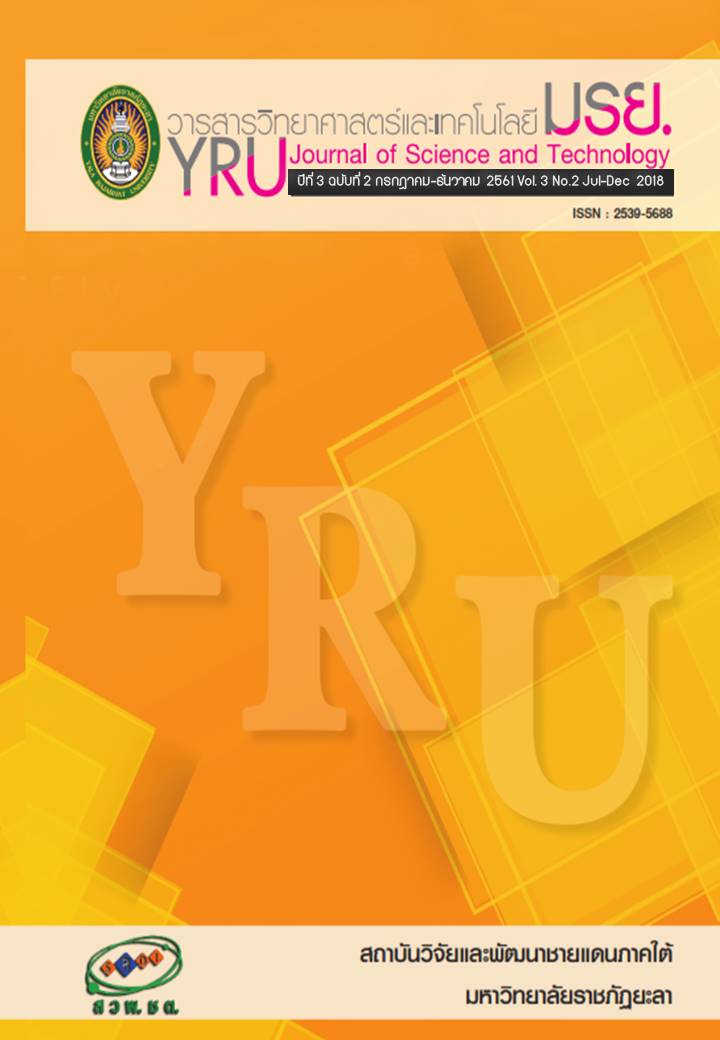การเปลี่ยนแปลงของเซลล์สืบพันธุ์เม่นทะเลหนามยาว Diadema setosum (Leske, 1778) จากบริเวณเกาะสีชัง จังหวัดชลบุรี ประเทศไทย : การศึกษาเบื้องต้น
Main Article Content
บทคัดย่อ
ในการศึกษาครั้งนี้คณะผู้วิจัยเลือกเม่นทะเล Diadema setosum เป็นสัตว์เฝ้าระวัง เพื่อศึกษาการเปลี่ยนแปลงของเซลล์สืบพันธุ์สำหรับทำนายสุขภาวะของอวัยวะสร้างเซลล์สืบพันธุ์ของเม่นทะเลจากบริเวณเกาะสีชัง จังหวัดชลบุรี ประเทศไทย เก็บตัวอย่างเม่นทะเลตัวเต็มวัยและเนื้อเยื่ออัณฑะและรังไข่จากช่วงฤดูร้อน ตั้งแต่เดือนกุมภาพันธุ์ถึงเดือนพฤษภาคม พ.ศ. 2560 เพศละ 5 ตัว ทำการวัดความยาวรัศมี คำนวณดัชนีเปอร์เซ็นต์ค่าดัชนีความสมบูรณ์เพศ เก็บเนื้อเยื่ออัณฑะ และรังไข่ เพื่อศึกษาชนิดและการเปลี่ยนแปลงของเซลล์สืบพันธุ์ทางมิญชวิทยา พบว่าเม่นทะเลเพศผู้มีความยาวรัศมี 7.36±0.34 เซนติเมตร และ 7.36±0.78 เซนติเมตร ในเม่นทะเลเพศเมีย และเปอร์เซ็นต์ค่าดัชนีสมบูรณ์เพศของเม่นทะเล เพศผู้และเพศเมียเท่ากับ 9.85±4.6 และ 10.70±4.16 ตามลำดับ ทั้งนี้ทั้งอัณฑะและรังไข่อยู่ในช่วงพัฒนาเซลล์สืบพันธุ์ พบเซลล์สืบพันธุ์หลายระยะในเม่นทะเลเพศผู้คือ ระยะสเปอร์มาโทไซต์ สเปอร์มาทิด และ สเปอร์มาโทซูน และพบเพียงแค่ฟอลลิเคิลระยะก่อนสะสมไข่แดงเท่านั้นในเม่นทะเลเพศเมีย สำหรับการเปลี่ยนแปลงทางด้านจุลกายพยาธิวิทยาเกิดขึ้นเพียงแค่ในเนื้อเยื่อรังไข่เท่านั้น โดยเฉพาะการฝ่อของเซลล์ไข่ในระยะก่อนสะสมไข่แดง การศึกษาครั้งนี้เป็นการศึกษาเบื้องต้น ดูเหมือนว่า รังไข่ของเม่นทะเลเพศเมียมีแนวโน้มลดจำนวนเซลล์ไข่และอาจมีผลกระทบต่อสุขภาวะของรังไข่ จำเป็นจะต้องมีการศึกษาถึงปัจจัยที่มีผลกระทบต่อความสมบูรณ์พันธุ์ของเม่นทะเลเพศเมียในอนาคตต่อไป
Article Details
บทความ ข้อมูล เนื้อหา รูปภาพ ฯลฯ ที่ได้รับการเผยแพร่ในวารสารวิทยาศาสตร์และเทคโนโลยี มรย. นี้ ถือเป็นลิขสิทธิ์ของวารสารวิทยาศาสตร์และเทคโนโลยี มรย. หากบุคคลหรือหน่วยงานใดต้องการนำทั้งหมดหรือส่วนหนึ่งส่วนใดไปเผยแพร่ต่อหรือกระทำการใดๆ จะต้องได้รับอนุญาตเป็นลายลักษณ์อักษรจากวารสารวิทยาศาสตร์และเทคโนโลยี มรย. ก่อนเท่านั้น
เอกสารอ้างอิง
2. Blazer, V.S. (2002). Histopathological assessment of gonadal tissue in wild fishes. Fish Physiology and Biochemistry, 26, 85–101.
3. Bronstein, O., Kroh, A. & Loya, Y. (2016). Reproduction of the long-spined sea urchin Diadema setosum in the Gulf of Aqaba - implications for the use of gonad-indexes. Scientific Reports, 6, 29569.
4. Byrne, M. (1990). Annual reproductive cycles of the commercial sea urchin Paracentrotus lividus from an exposed intertidal and a sheltered sub-tidal habitat on the west coast of Ireland. Marine Biology, 104, 275–289.
5. Drummond, A. E. (2011). Reproduction of the sea urchin Stomopneustes variolaris (Lam.) on the east coast of South Africa. Invertebrate Reproduction & Development, 20, 259–266.
6. Drummond, A. E. (1995). Reproduction of the sea urchins Echinometra mathaei and Diadema savignyi on the South African Eastern Coast. Marine and Freshwater Research, 46, 751–755.
7. Frame, L., & Dickerson, R.L. (2006). Fish and wildlife as sentinels of environment contamination. In D.O. Norris and J.A. Carr (eds.), Endocrine disruption: biological bases for health effects in wildlife and humans, pp. 202-222. New York: Oxford University Press.
8. Lowe, V.L. & Pipe, R.K. (1986). Hydrocarbon exposure in mussels: a quantitative study of the responses in the reproductive and nutrient storage cell systems. Aquatic Toxicology, 20(3), 259-265.
9. National Research Council (NRC). (1991). Animals as sentinel of environmental health hazards. Washington D.C.: National Academy Press.
10. Meidel, S. K. & Scheibling, R.E. (1998). Annual reproductive cycle of the green sea urchin, Strongylocentrotus droebachiensis, in differing habitats in Nova Scotia, Canada. Marine Biology, 131, 461-478.
11. Naidenko, T. (1997). Abnormality of development in Strongylocentus intermedius (A. Agassiz) Larvae from polluted habitat in Amursky Bay, Peter the Great Bay. The Publications of the Seto Marine Biological Laboratory, 38, 1-11.
12. Presnell, J. K. and Schreibman, M. P. (1997). Humason’s Animal Tissue Techniques. (5th ed.). USA: Johns Hopkins University Press.
13. Quddus Khan, M. A., Al-Ghais, S. M., Catalin, B. & Khan, Y. H. (2005). Effects of petroleum hydrocarbons on aquatic animals. In Oil Pollution and its Environmental Impact in the Arabian Gulf Region. M. Al-Azab, W. El-Shorbagy and S. Al-Ghais, (editors), pp. 159–185, Elsevier B. V.
14. Senarat, S., Poolprasert, P. & Yenchum, W. (2013). Histological changes of gonadal tissues in Red-tailed Tinfoil, Barbonymus altus from Tapee River, Nakhon Sri Thammarat Province. Journal of Science & Technology of Ubonratchathane University, 15, 10-20. (Abstract in English)
15. Schäfer, S. and Köhler, A. (2009). Gonadal lesions of female sea urchin (Psammechinus miliaris) after exposure to the polycyclic aromatic hydrocarbon phenanthrene. Marine Environmental Research, 68, 128-136.
16. Schäfer, S., Abele, D., Weihe, E. & Köhler, A. (2011). Sex-specific biochemical and histological differences in gonads of sea urchins (Psammechinus miliaris) and their response to phenanthrene exposure. Marine Environmental Research, 71, 70-78.
17. Suvarna, K.S., Layton, C. & Bancroft, J.D. (2013). Bancroft’s Theory and Practice of Histological Techniques. (7th ed.) Canada: Elsevier.
18. USEPA. (1996). Drinking water regulation and health advisories, USEPA Office of Water, Washinton, DC.
Wattanayakorn, G. and Rungsupa, S. (2012). Petroleum hydrocarbon residues in the marine environment of Koh Sichang-Sriracha, Thailand. Coastal Marine Science, 35, 122-128.
19. Wilson, J. M., Bunte, R. M., Carty, A. J. (2009). Evaluation of rapid cooling and tricaine methanesulfonate (MS 222) as methods of euthanasia in zebra fish (Danio rerio). Journal of the American Association for Laboratory Animal Science, 48, 785-789.


